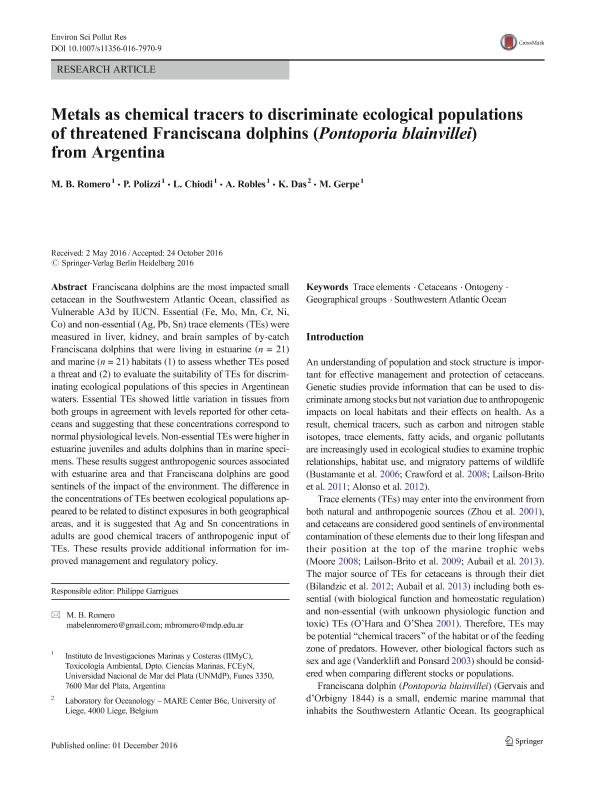Artículo
Metals as chemical tracers to discriminate ecological populations of threatened Franciscana dolphins (Pontoporia blainvillei) from Argentina
Romero, María Belén ; Polizzi, Paula Sabrina
; Polizzi, Paula Sabrina ; Chiodi Boudet, Leila Natalia
; Chiodi Boudet, Leila Natalia ; Robles, Alicia Daniela
; Robles, Alicia Daniela ; Das, Kalyan; Gerpe, Marcela Silvia
; Das, Kalyan; Gerpe, Marcela Silvia
 ; Polizzi, Paula Sabrina
; Polizzi, Paula Sabrina ; Chiodi Boudet, Leila Natalia
; Chiodi Boudet, Leila Natalia ; Robles, Alicia Daniela
; Robles, Alicia Daniela ; Das, Kalyan; Gerpe, Marcela Silvia
; Das, Kalyan; Gerpe, Marcela Silvia
Fecha de publicación:
02/2017
Editorial:
Springer Heidelberg
Revista:
Environmental Science and Pollution Research
ISSN:
0944-1344
e-ISSN:
1614-7499
Idioma:
Inglés
Tipo de recurso:
Artículo publicado
Clasificación temática:
Resumen
Franciscana dolphins are the most impacted small cetacean in the Southwestern Atlantic Ocean, classified as Vulnerable A3d by IUCN. Essential (Fe, Mo, Mn, Cr, Ni, Co) and non-essential (Ag, Pb, Sn) trace elements (TEs) were measured in liver, kidney, and brain samples of by-catch Franciscana dolphins that were living in estuarine (n = 21) and marine (n = 21) habitats (1) to assess whether TEs posed a threat and (2) to evaluate the suitability of TEs for discriminating ecological populations of this species in Argentinean waters. Essential TEs showed little variation in tissues from both groups in agreement with levels reported for other cetaceans and suggesting that these concentrations correspond to normal physiological levels. Non-essential TEs were higher in estuarine juveniles and adults dolphins than in marine specimens. These results suggest anthropogenic sources associated with estuarine area and that Franciscana dolphins are good sentinels of the impact of the environment. The difference in the concentrations of TEs beetwen ecological populations appeared to be related to distinct exposures in both geographical areas, and it is suggested that Ag and Sn concentrations in adults are good chemical tracers of anthropogenic input of TEs. These results provide additional information for improved management and regulatory policy.
Archivos asociados
Licencia
Identificadores
Colecciones
Articulos(IIMYC)
Articulos de INSTITUTO DE INVESTIGACIONES MARINAS Y COSTERAS
Articulos de INSTITUTO DE INVESTIGACIONES MARINAS Y COSTERAS
Citación
Romero, María Belén; Polizzi, Paula Sabrina; Chiodi Boudet, Leila Natalia; Robles, Alicia Daniela; Das, Kalyan; et al.; Metals as chemical tracers to discriminate ecological populations of threatened Franciscana dolphins (Pontoporia blainvillei) from Argentina; Springer Heidelberg; Environmental Science and Pollution Research; 24; 4; 2-2017; 3940-3950
Compartir
Altmétricas



